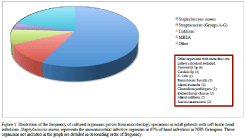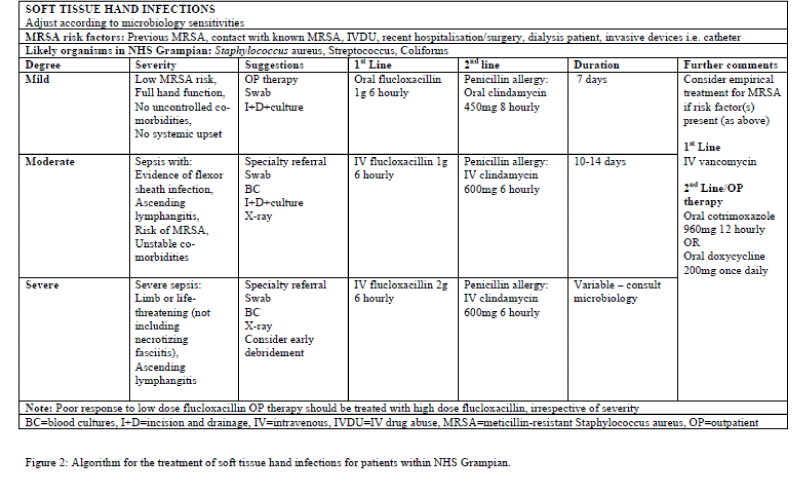
Research Article
Austin J Musculoskelet Disord. 2014;1(1): 1004.
Causative Organisms in Soft Tissue Infections of the Hand: Challenging Current Antimicrobial Prescribing Practices
Watson HI*, Hassan S and Davies M
Department of Plastic and Reconstructive Surgery, Aberdeen Royal Infirmary, Aberdeen, UK
*Corresponding author: Watson HI, Department of Plastic and Reconstructive Surgery, Aberdeen Royal Infirmary, Aberdeen, UK
Received: July 22, 2014; Accepted: Aug 01, 2014; Published: Aug 02, 2014
Abstract
Soft tissue hand cellulitis is an increasingly common presentation to secondary care facilities in the United Kingdom. The aim of this study was to determine the incidence of meticillin-resistant Staphylococcus aureus (MRSA) hand infections in a Scottish teaching hospital and improve upon current antimicrobial prescribing advice. A retrospective review was carried out over an 18-month period: 175 microbiology specimens from 148 adults were identified. Prevalence of hand infections in our institute is <0.1% with Staphylococcus aureus identified as the monomicrobial causative pathogen in 67% of cases. The incidence of MRSA was 4% in our patient population.
Keywords: MRSA; Cellulitis; Hand; Antibiotics; Guidelines
Introduction
Soft tissue cellulitis of the hand is an increasingly common presentation to secondary care facilities in the United Kingdom. Suboptimal or delayed management has the potential to result in longterm impairment of hand function [1]. Additionally, varied clinical presentation coupled with diverse causative microorganisms can cause diagnostic uncertainty, whilst use of sub-maximal antimicrobial doses in the community may lead to a protracted course of infection [2]. The most common presentation of superficial cellulitis involves the dermis and subcutaneous fat, followed by tendon, bone and joint involvement [3].
Staphylococcus aureus remains the most common organism leading to soft tissue infections in the community [4]. However, a growing proportion is now designated meticillin-resistant Staphylococcus aureus (MRSA). MRSA was first isolated in 1961 and has been a perennial concern since discovery; this was just one year after the introduction of meticillin [5]. From as early as 1963, scientific documentation had begun to describe endemic levels of MRSA within certain hospital populations [6]. The incidence of community MRSA hand infections in the United States has risen with a reported prevalence of 55% expanding to 73% [7,8,9]. Crucially, this is equally true for populations without known MRSA risk factors [8].
Common risk factors for MRSA include a history of diabetes or immunocompromise, obesity, intravenous drug use, recurrent hospital admissions, prolonged antibiotic use and naturally close proximity to MRSA positive individuals [10]. The presence of any one of these risk factors should prompt the clinician to consider early empirical treatment for this pathogen prior to microbiological confirmation. Early treatment of MRSA soft tissue infections is essential to allow the best management outcome for individual patients [11].
The aim of this study was to determine the prevalence of MRSA hand infections in NHS Grampian and describe causative organisms of hand cellulitis, and to improve upon current antimicrobial prescribing advice.
Methods
A retrospective review of all cases of adult hand infections presenting to NHS Grampian over an 18-month period from March 2012 until September 2013 was carried out. Patients were identified using a hospital microbiology database. Search terms included hand, finger, thumb and wrist. Full data sets were collected for: age, sex, microbiology specimen site and causative organism. Additionally, partial data sets were analysed for antibiotic administration and associated fracture or bite (animal or fight) injury. A review of all available hand radiographs was undertaken to identify co-existing fractures or soft tissue injuries.
Results
A total of 175 microbiology specimens from 148 adults were identified with a male to female ratio of 3.1:1.0 and an average age of 52 years (range 18 to 93). Prevalence of hand infections in our institute is <0.1% with Staphylococcus aureus identified as the monomicrobial causative pathogen in 67% of cases. By comparison, the incidence of MRSA was 4% in our patient population, affecting two females and four males. Polymicrobial infections were present in twentytwo patients; this encompassed six females each with two causative organisms and sixteen males with a range of two to four causative organisms. In total, sixty-four patients had hand radiographs. Twelve patients presented with an underlying phalynx fracture, seven of which were open. Figure 1 illustrates the causative pathogens isolated on microbiology swab culture.

Figure 1:
Discussion
The incidence of MRSA in our institution is much lower than that reported in the United States but considerably higher than that reported elsewhere in Scotland [12]. It is out with the scope of this study to determine the cause of this, however it is hypothesised that a high rate of intravenous drug use locally may have a role to play. The Centers for Disease Control and Prevention recommend empirical treatment for coverage of MRSA if the local prevalence exceeds 10% [13]; this is not the case in our institute. The most common causative organism in this study is Staphylococcus aureus, in keeping with other published series [14]. A Cochrane review identified twentyfive randomised clinical trials that compare efficacy of different antimicrobials in the treatment of cellulitis, but was not able to define best antimicrobial treatment for cellulitis [15]. Current antimicrobial prescribing guidelines in our institute recommend dual therapy flucloxacillin and amoxicillin for mild cellulitis, whilst a combination of intravenous flucloxacillin and benzylpenicillin is recommended for moderate and severe cellulitis. No specific mention of the unique challenges of treating hand cellulitis is made. The suggested flucloxacillin doses are sub-maximal, at 500mg for mild and moderate and 1g for severe infections. The use of dual therapy antimicrobials has been challenged in the context of lower limb cellulitis, with no difference observed in treatment efficacy between monotherapy with flucloxacillin and dual therapy [16]. This is understandable, as flucloxacillin has both staphylococcal and streptococcal properties, whilst benzylpenicillin is effective for streptococcal infections only.
Increasing emergence of MRSA has seen a shift in recommendations of second line antibiotics in the penicillin allergic patient from clarithromycin to clindamycin. Clindamycin has established activity against many infections caused by communityacquired MRSA. Importantly, it also has near complete absorption following oral administration and a serum concentration that approximate those found after intravenous administration thus facilitating intravenous to oral switch [17].
Antimicrobial therapy should ideally be utilised only in the context of complicated soft tissue infections that are associated with co-morbidities, failure of incision and drainage, as well as at the extremes of age. Those with risk factors for MRSA, were the local prevalence rate is above 10%, should be considered for early treatment with antimicrobials active against MRSA.
This review adds local knowledge to the progression of areaspecific antimicrobial stewardship to encourage local sensitivities to guide individual hospital antimicrobial guidelines. Our results also suggest that monotherapy flucloxacillin would be an appropriate prescription within NHS Grampian for soft tissue infections.
This review is hindered by nature of being a retrospective review, which places limits on data collection and the completeness of individual data sets
Conclusion
The focus of treatment for hand cellulitis remains early detection and limb elevation with gentle passive mobilization of digits. These supportive measures must be used alongside surgical incision and drainage as necessary and appropriate antimicrobial therapy when merited. Alongside these measures, it is recommended that all moderate and severe cases are assessed by an upper limb surgical specialty and that microbiology and/or infectious diseases advice is sought as appropriate. MRSA has an incidence of 4% within our patient population. With respect to antimicrobial stewardship, local antimicrobial guidelines should be followed with MRSA cover incorporated based on microbiology evidence or associated risk factors.
Presented is an algorithm (Figure 2) aimed to standardise antimicrobial prescribing and approved for use by the Antimicrobial Prescribing Group for NHS Grampian. This algorithm is based on local causative organisms and is in line with best available evidence.

Figure 2:
References
- Clark DC. Common acute hand infections. See comment in PubMed Commons below Am Fam Physician. 2003; 68: 2167-2176.
- Halilovic J, Heintz BH, Brown J. Risk factors for clinical failure in patients hospitalized with cellulitis and cutaneous abscess. See comment in PubMed Commons below J Infect. 2012; 65: 128-134.
- Houshian S, Seyedipour S, Wedderkopp N. Epidemiology of bacterial hand infections. See comment in PubMed Commons below Int J Infect Dis. 2006; 10: 315-319.
- Ray GT, Suaya JA, Baxter R. Microbiology of skin and soft tissue infections in the age of community-associated methicillin-resistant Staphylococcus aureus. Diagn Microbiol Infect Dise. 2013; 76: 24-30.
- Jevons MP. “Celbenin” – resistant Staphylococci. Br Med J 1961; 1:124-125.
- JEVONS MP, COE AW, PARKER MT. Methicillin resistance in staphylococci. See comment in PubMed Commons below Lancet. 1963; 1: 904-907.
- Bach HG, Steffin B, Chhadia AM, Kovachevich R, Gonzalez MH. Community-associated methicillin-resistant Staphylococcus aureus hand infections in an urban setting. See comment in PubMed Commons below J Hand Surg Am. 2007; 32: 380-383.
- Fridkin SK, Hageman JC, Morrison M, Sanza LT, Como-Sabetti K, Jernigan JA. Methicillin-resistant Staphylococcus aureus disease in three communities. See comment in PubMed Commons below N Engl J Med. 2005; 352: 1436-1444.
- O'Malley M, Fowler J, Ilyas AM. Community-acquired methicillin-resistant Staphylococcus aureus infections of the hand: prevalence and timeliness of treatment. See comment in PubMed Commons below J Hand Surg Am. 2009; 34: 504-508.
- Dryden MS. Skin and soft tissue infection: microbiology and epidemiology. See comment in PubMed Commons below Int J Antimicrob Agents. 2009; 34 Suppl 1: S2-7.
- Bassetti M, Nicco E, Mikulska M. Why is community-associated MRSA spreading across the world and how will it change clinical practice? See comment in PubMed Commons below Int J Antimicrob Agents. 2009; 34 Suppl 1: S15-19.
- Hassan S, Gashau W, Balchin L, et al. Incidence of community-acquired meticillin resistant Staphylococcus aureus hand infections in Tayside, Scotland: a guide to appropriate antimicrobial prescribing. J Hand Surg Eur Vol. 2011; 36: 226-229.
- Gorwitz RJ, Jernigan DB, Powers JH, Jernigan JA and Participants in the CDC-Convened Experts’ Meeting on Management of MRSA in the Community. Strategies for the clinical management of MRSA in the community: summary of an experts’ meeting convened by the CDC. Atlanta, GA: Centers for Disease Control and Prevention, 2006.
- Chong CW, Ormston VE, Tan AB. Epidemiology of hand infection--a comparative study between year 2000 and 2009. See comment in PubMed Commons below Hand Surg. 2013; 18: 307-312.
- Kilburn SA, Featherstone P, Higgins B, Brindle R. Interventions for cellulitis and erysipelas. See comment in PubMed Commons below Cochrane Database Syst Rev. 2010; : CD004299.
- Leman P, Mukherjee D. Flucloxacillin alone or combined with benzylpenicillin to treat lower limb a346.
- Frank AL, Marcinak JF, Mangat PD, Tjhio JT, Kelkar S, Schreckenberger PC. Clindamycin treatment of methicillin-resistant Staphylococcus aureus infections in children. See comment in PubMed Commons below Pediatr Infect Dis J. 2002; 21: 530-534.